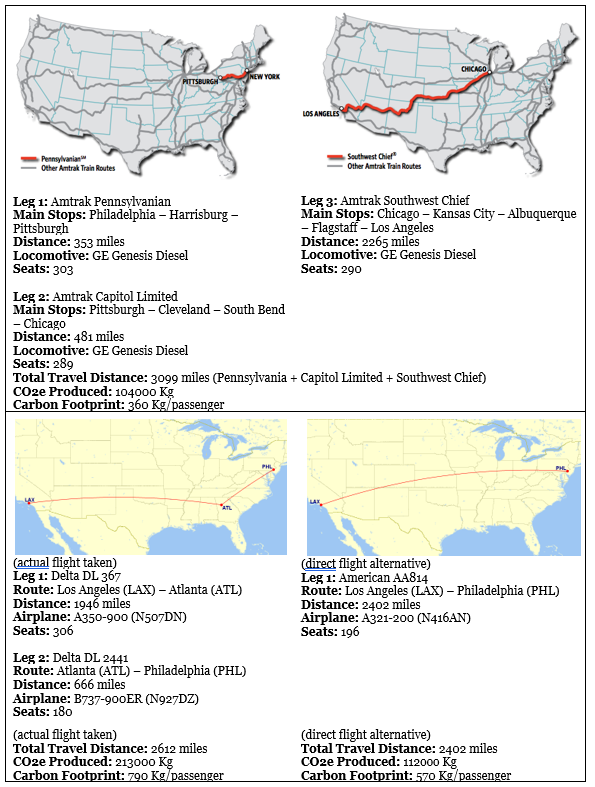
Traveling Across the United States the Old-Fashioned Way
Why developing and expanding passenger rail in the United States is critical in the fight against climate change.
For my winter break this year I decided to travel to southern California. However, unlike most people heading west, I took Amtrak! My transcontinental, 3000-mile-long journey had me ride three iconic train lines in the span of 82 hours: the Pennsylvanian from Philadelphia to Pittsburgh, the Capitol Limited from Pittsburgh to Chicago, and the legendary Southwest Chief from Chicago to Los Angeles via Kansas City, Albuquerque, and Flagstaff.

Family, friends, and even professors have poked fun at me for choosing to take the train instead of the plane to get to the other coast from Philadelphia. However, as an energy researcher, my decision was motivated by the fact that trains, whether for cargo or passengers, pollute much less than airplanes, sometimes by as much as 73%, and they are more easily electrified than planes. Traveling the old-fashioned way would allow me to reduce my carbon footprint, in quite a significant way. In fact, by 54%, as demonstrated in Tables 1 & 2.

These numbers illustrate the undeniable truth: Rail is a cleaner transportation alternative to flights and has the lowest emissions per passenger mile ratio than any other means of transport, especially on short routes like those covered by the northeast regional.
I’m a strong believer in using rail as a means of decarbonizing the transportation industry. Aviation in the United States, both domestic and international, contributes to 0.5% of the global CO2 emissions; thus, replacing flights with rail could have a tremendous positive impact on the environment. The French government has already taken notice of aviation’s carbon footprint and has passed a law to replace several domestic flights in the country with rail alternatives. The United States could implement a similar policy, especially in the northeast, where the large population centers are robustly connected by multiple rail services per day. However, unlike France, the vast majority of the U.S. rail networks, are lacking and under-maintained. Amtrak’s rail network only spans 21,300 miles, 19.9% of what it used to be in 1958 at its apex. In addition, the system only contains five transcontinental routes.
| Category | Emissions from Rail | Emissions from Flight (direct) | Emissions from Flight (taken) |
|---|---|---|---|
| Route | Pennsylvanian + Capitol Limited + Southwest Chief | LAX – PHL | LAX – ATL + ATL – PHL |
| Total CO2e | 104000 Kg | 112000 Kg | 213000 Kg |
| Carbon footprint | 360 Kg/passenger | 570 Kg/passenger | 790 Kg/passenger |
| Footprint as a % of rail | 100% | 158% | 219% |
| Emissions reductions from rail as a % | 0% | 37% | 54% |
The importance of rail, not only as a way of serving remote “fly-over” communities but also in reducing greenhouse gas emissions, leads me to advocate for three concrete points.
- We must invest in enhancing the rail infrastructure, especially outside of the northeast regional. If we want to encourage more people to ride trains, we need to not only open more lines but also increase the frequency of existing lines between major population centers. Furthermore, this expansion should be accompanied by system-wide electrification, as well as the development of hydrogen technologies for use in long-distance train travel.
- We must pursue policies that encourage private companies to enter the passenger rail market and operate routes themselves. An example of this would be Brightline, which is set to open a high-speed line between Miami and Orlando with multiple round trips per day. Brightline’s operations would not cannibalize Amtrak’s, but rather complement them, given that the government-owned entity only operates a once-daily service between the two cities as part of their Silver Meteor line. Considering that there are 11 daily flights between the 240 miles that separate the Miami area and Orlando, there is great potential to further develop rail and reduce the emissions from the short-haul flights.
- We must advocate for behavioral change and acknowledge civil aviation as a right rather than a privilege. This doesn’t mean that everyone should now ride the Southwest Chief to cross the country in an attempt to reduce emissions. However, we can encourage ridership and investment in rail by imposing a carbon tax. Thus, in order to fly, we would need to pay more to compensate for the cost of the pollution we generate.
In my old-fashioned Amtrak travels, I was pleasantly surprised to see a load factor of almost 100%. Indeed, a non-trivial number of people want to ride trains, and I’m sure that with a more extensive network, better infrastructure, and a change in the way Americans think about transportation, we could see a substantial increase in rail ridership. It would benefit fly-over communities, travelers, and the planet!
This insight is a part of our Undergraduate Seminar Fellows’ Student Blog Series. Learn more about the Undergraduate Climate and Energy Seminar.
Andrés Eskenazi
Undergraduate Seminar FellowAndrés Eskenazi is an undergraduate and master’s student studying math and mechanical engineering as part of the Vagelos Integrated Program in Energy Research (VIPER). Eskenazi is also a 2022 Undergraduate Student Fellow.

